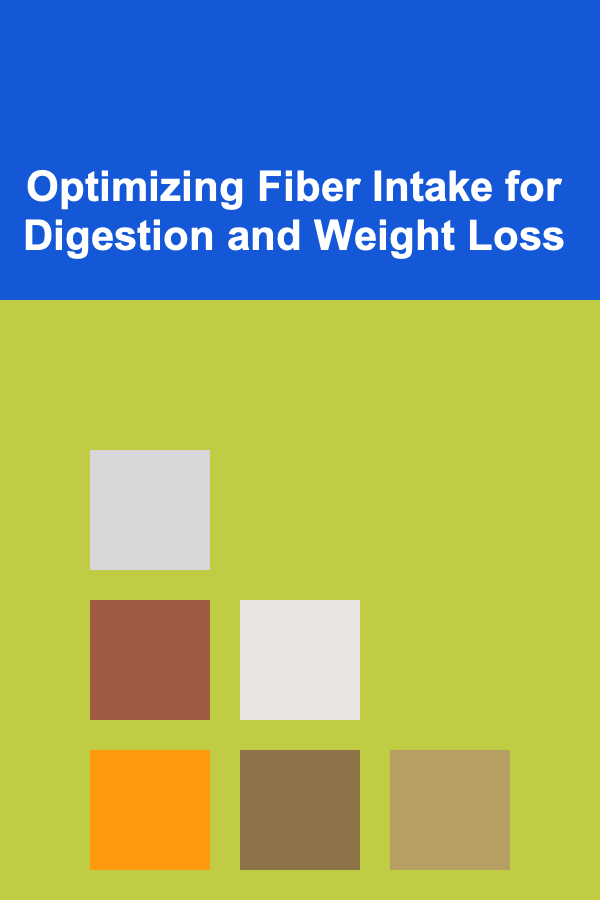
Optimizing Fiber Intake for Digestion and Weight Loss
ebook include PDF & Audio bundle (Micro Guide)
$12.99$8.99
Limited Time Offer! Order within the next:

Introduction: The Underappreciated Power of Fiber
In the realm of nutrition, fiber often plays second fiddle to macronutrients like protein, carbohydrates, and fats. However, fiber is a nutritional powerhouse with profound implications for both digestive health and weight management. It's a type of carbohydrate that your body can't digest. Instead, it passes relatively intact through your digestive system, playing a vital role in regulating blood sugar, promoting satiety, and nourishing beneficial gut bacteria. This comprehensive guide delves into the multifaceted benefits of fiber, exploring how to strategically optimize your intake for improved digestion, sustainable weight loss, and overall well-being.
Understanding Fiber: Soluble vs. Insoluble
Fiber isn't a monolithic entity; it comprises different types, each with distinct properties and effects on the body. The two primary categories are soluble and insoluble fiber.
Soluble Fiber: The Gut's Gentle Helper
Soluble fiber dissolves in water, forming a gel-like substance in the digestive tract. This gel slows down the rate at which food empties from your stomach, leading to increased satiety and potentially reducing overall calorie intake. Furthermore, soluble fiber can help lower LDL ("bad") cholesterol levels by binding to cholesterol in the digestive system and preventing its absorption. It also helps regulate blood sugar by slowing glucose absorption.
Food Sources of Soluble Fiber:
- Oats
- Barley
- Apples
- Citrus fruits
- Beans (kidney, pinto, black)
- Peas
- Carrots
Insoluble Fiber: The Digestive Tract's Scrub Brush
Insoluble fiber doesn't dissolve in water. Instead, it adds bulk to the stool and helps speed up the passage of waste through the digestive system. This is crucial for preventing constipation and promoting regular bowel movements. Insoluble fiber also contributes to feelings of fullness and may help regulate blood sugar by slowing down the absorption of carbohydrates.
Food Sources of Insoluble Fiber:
- Whole wheat bread
- Bran cereals
- Vegetables (especially the skins of fruits and vegetables)
- Nuts
- Seeds
The Importance of Balance
While both soluble and insoluble fiber are beneficial, it's important to consume a balance of both for optimal health. Most plant-based foods contain a mix of both types of fiber, but some are richer in one type than the other. Aim to incorporate a variety of fiber-rich foods into your diet to reap the full spectrum of benefits.
Fiber and Digestion: A Symbiotic Relationship
The digestive system is a complex ecosystem, and fiber plays a pivotal role in maintaining its health and functionality.
Promoting Regularity and Preventing Constipation
One of the most well-known benefits of fiber is its ability to prevent and alleviate constipation. Insoluble fiber adds bulk to the stool, making it easier to pass through the digestive tract. Soluble fiber absorbs water, softening the stool and further facilitating its passage. Adequate fiber intake, along with sufficient hydration, is essential for maintaining regular bowel movements.
Nourishing Gut Microbiota: The Foundation of Health
Fiber acts as a prebiotic, meaning it serves as food for the beneficial bacteria in your gut. These bacteria ferment fiber, producing short-chain fatty acids (SCFAs) like butyrate, acetate, and propionate. SCFAs have a wide range of beneficial effects, including:
- Reducing inflammation: SCFAs can help modulate the immune system and reduce inflammation throughout the body.
- Improving gut barrier function: Butyrate, in particular, is a primary energy source for colonocytes (the cells lining the colon) and helps maintain the integrity of the gut barrier, preventing "leaky gut."
- Regulating appetite: SCFAs can influence hormone production, potentially impacting appetite and food intake.
- Improving insulin sensitivity: Some research suggests that SCFAs may enhance insulin sensitivity, which is crucial for blood sugar control.
A diverse and thriving gut microbiome is linked to numerous health benefits, including improved digestion, a stronger immune system, and a reduced risk of chronic diseases.
Reducing the Risk of Digestive Disorders
Studies have shown that a high-fiber diet can reduce the risk of various digestive disorders, including:
- Diverticulitis: Fiber helps prevent the formation of small pouches (diverticula) in the colon wall and reduces the risk of inflammation (diverticulitis).
- Hemorrhoids: By promoting regular bowel movements and reducing straining, fiber can help prevent hemorrhoids.
- Colon Cancer: While more research is needed, some studies suggest that a high-fiber diet may be associated with a lower risk of colon cancer. This may be due to the ability of fiber to bind to carcinogens and promote their elimination from the body, as well as the beneficial effects of SCFAs on colon health.
Fiber and Weight Loss: A Powerful Ally
Fiber can be a valuable tool for weight management, contributing to feelings of fullness, regulating blood sugar, and potentially reducing calorie absorption.
Promoting Satiety and Reducing Calorie Intake
Fiber-rich foods tend to be more filling than processed foods that are low in fiber. This is because fiber adds bulk to the diet and slows down the rate at which food empties from the stomach. As a result, you're likely to feel fuller for longer and consume fewer calories overall. Choosing high-fiber options can naturally reduce portion sizes and prevent overeating.
Regulating Blood Sugar and Preventing Cravings
Fiber, especially soluble fiber, helps regulate blood sugar levels by slowing down the absorption of glucose. This prevents rapid spikes and crashes in blood sugar, which can lead to cravings, particularly for sugary and processed foods. By maintaining stable blood sugar levels, fiber can help control appetite and reduce the likelihood of impulsive eating.
Potential for Reduced Calorie Absorption
While the direct impact is debated, some research suggests that fiber may interfere with the absorption of calories from other foods. Fiber can bind to fats and cholesterol in the digestive tract, preventing their absorption and promoting their elimination. Furthermore, the fermentation of fiber by gut bacteria produces SCFAs, which may influence energy metabolism and fat storage. However, more research is needed to fully understand the extent of this effect.
Fiber and the Thermic Effect of Food (TEF)
The thermic effect of food refers to the energy expenditure associated with digesting, absorbing, and processing nutrients. Fiber-rich foods, particularly whole, unprocessed sources, often require more energy to digest compared to highly processed foods. This can contribute to a slightly higher TEF, meaning you burn more calories simply by digesting the food.
Recommended Fiber Intake: How Much Do You Need?
The recommended daily intake of fiber varies depending on age and sex. However, a general guideline for adults is:
- Women: 25 grams per day
- Men: 38 grams per day
Unfortunately, most people fall short of these recommendations. The average American consumes only about 15 grams of fiber per day. Increasing your fiber intake gradually is crucial to avoid digestive discomfort.
Strategies for Optimizing Your Fiber Intake
Incorporating more fiber into your diet doesn't have to be a daunting task. Here are some practical strategies to help you increase your fiber intake gradually and effectively:
Start Slowly and Increase Gradually
Abruptly increasing your fiber intake can lead to digestive discomfort, such as bloating, gas, and constipation. It's best to start with small changes and gradually increase your fiber intake over several weeks to allow your digestive system to adapt. Begin by adding a serving of beans or a handful of nuts to your daily diet and gradually increase the amount as tolerated.
Choose Whole Grains Over Refined Grains
Swap refined grains, such as white bread, white rice, and processed cereals, for whole grains like whole wheat bread, brown rice, quinoa, and oats. Whole grains retain the bran and germ, which are rich in fiber and other nutrients. Look for products that list "whole wheat" or "whole grain" as the first ingredient.
Load Up on Fruits and Vegetables
Fruits and vegetables are excellent sources of fiber, vitamins, and minerals. Aim to include a variety of fruits and vegetables in your daily diet, focusing on those with edible skins, such as apples, pears, berries, and potatoes. Choose whole fruits over fruit juices, as the juicing process removes much of the fiber.
Embrace Legumes: Beans, Lentils, and Peas
Legumes are nutritional powerhouses, packed with fiber, protein, and essential nutrients. Add beans, lentils, or peas to soups, salads, stews, or side dishes. Canned beans are a convenient option, but be sure to rinse them thoroughly to remove excess sodium.
Add Nuts and Seeds to Your Diet
Nuts and seeds are good sources of fiber, healthy fats, and protein. Sprinkle them on salads, yogurt, or oatmeal, or enjoy them as a snack. Choose unsalted varieties to minimize sodium intake.
Read Food Labels Carefully
Pay attention to the nutrition labels on packaged foods to determine the fiber content. Look for foods that contain at least 3 grams of fiber per serving. Be wary of products that claim to be "high in fiber" but contain added sugars or artificial ingredients.
Stay Hydrated
Drinking plenty of water is crucial when increasing your fiber intake. Fiber absorbs water, and inadequate fluid intake can lead to constipation. Aim for at least eight glasses of water per day, and increase your fluid intake further if you're physically active.
Consider a Fiber Supplement (with Caution)
If you're struggling to meet your fiber needs through diet alone, you may consider taking a fiber supplement. However, it's important to choose a supplement wisely and use it as a complement to a healthy diet, not as a replacement. Common fiber supplements include psyllium husk, methylcellulose, and inulin. Start with a low dose and gradually increase it as tolerated. Be sure to drink plenty of water when taking a fiber supplement to prevent constipation. Consult with your doctor or a registered dietitian before starting any new supplement regimen.
Potential Side Effects and Precautions
While fiber is generally beneficial, it's important to be aware of potential side effects and precautions:
Gas, Bloating, and Abdominal Discomfort
As mentioned earlier, increasing your fiber intake too quickly can lead to gas, bloating, and abdominal discomfort. This is because the gut bacteria ferment the fiber, producing gas as a byproduct. Increasing your fiber intake gradually allows your gut bacteria to adapt and minimize these side effects.
Nutrient Absorption
In very high doses, fiber may interfere with the absorption of certain minerals, such as iron, zinc, and calcium. However, this is usually only a concern for individuals with very poor diets or those taking very high doses of fiber supplements. Consuming a balanced diet and increasing fiber intake gradually should minimize this risk.
Medication Interactions
Fiber can potentially interfere with the absorption of certain medications. If you're taking any medications, it's important to talk to your doctor or pharmacist before significantly increasing your fiber intake or taking fiber supplements. They may recommend adjusting the timing of your medication to avoid any potential interactions.
Individuals with Certain Medical Conditions
Individuals with certain medical conditions, such as irritable bowel syndrome (IBS), Crohn's disease, or ulcerative colitis, may need to be more cautious when increasing their fiber intake. Some types of fiber may exacerbate symptoms in these individuals. It's crucial to work with a doctor or registered dietitian to determine the appropriate type and amount of fiber for your individual needs.
Conclusion: Embracing Fiber for a Healthier You
Optimizing your fiber intake is a cornerstone of a healthy lifestyle. From promoting digestive regularity and nourishing beneficial gut bacteria to aiding in weight management and reducing the risk of chronic diseases, the benefits of fiber are undeniable. By understanding the different types of fiber, gradually increasing your intake through whole, unprocessed foods, and staying hydrated, you can harness the power of fiber to improve your digestion, achieve your weight loss goals, and enhance your overall well-being. Remember to listen to your body and adjust your fiber intake as needed. Embracing fiber is an investment in a healthier, happier you.

How to Create an Efficient System for Grocery Shopping
Read More
How to Incorporate Metallic Elements into Your Holiday Decor
Read More
How to Keep Your Home Safe with Regular Security System Maintenance
Read More
How to Stage Your Home for the Spring or Summer Market
Read More
How to Use Color Psychology to Energize Your Workout Space
Read More
Long-Distance Love: Making Relationships Work Across Miles
Read MoreOther Products

How to Create an Efficient System for Grocery Shopping
Read More
How to Incorporate Metallic Elements into Your Holiday Decor
Read More
How to Keep Your Home Safe with Regular Security System Maintenance
Read More
How to Stage Your Home for the Spring or Summer Market
Read More
How to Use Color Psychology to Energize Your Workout Space
Read More